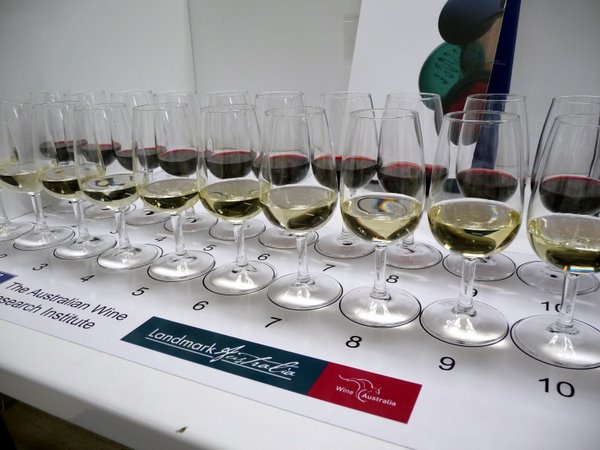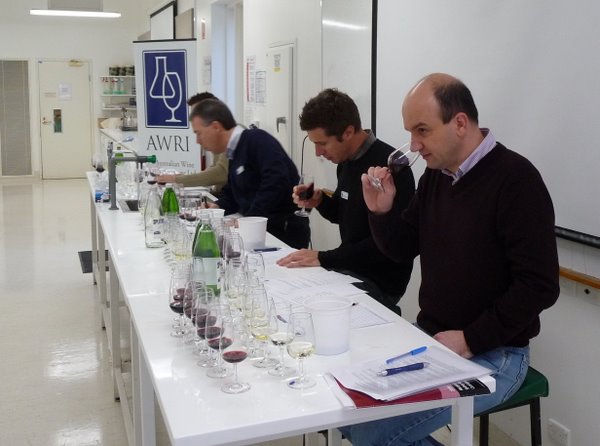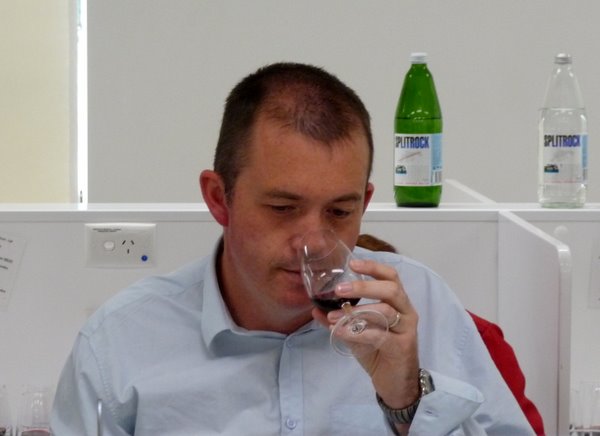|
Part
2: The Australian Wine Research Institute
Landmark Australia
Tutorial
Website:
www.landmark-wineaustralia.com

It
was smart of the organizers of the Landmark Tutorial to begin the
week with a visit to the Australian Wine Research Institute (AWRI),
because this is one of the jewels of the country’s wine industry.
The AWRI rightly considers itself to be a provider of resources to
the Australian Wine industry. Every grape grower and winemaker pays
a levy, and the Federal Government then doubles this. The budget
works out at about A$60 m for wine research, which is slightly less
than what Bordeaux spends on research and marketing. As a private
company, though, the AWRI has to compete for this pot.
There
are four streams of activity. Research accounts for some 70% of the
AWRI’s activity, and it is headed up by Marcus Herderich. Then
there’s development work, which is run by Peter Godden. An example
of this would be the development of Near Infra Red (NIR)
spectroscopy for non destructive testing of wine. The third area is
extension work – taking research and disseminating it to the
growers and winemakers. This area is looked after by Con Simos, and
it includes AWACs (advanced wine assessment courses), publications,
and the Australian Wine Industry Technical Conference. Getting
research outcomes out to industry is seen as a high priority.
Finally, there is the commercial service, run by
Vince O’Brien, which is in effect a ‘pay per view’
set-up. Samples are submitted for analysis – as many as 100 000 in
a year. This gives the AWRI a valuable snapshot of what is going on
in the Australian wine industry. For example, data now exist on
trends in alcohol levels, volatile acidity and Brettanomyces.
We
were given some examples of the sorts of projects the AWRI has been
involved with. One recent, newsworthy project has been the
identification of a compound responsible for pepperiness in
Australian Shiraz. Called rotundone, it is found in lots of herbs
and vegetables, and it’s incredibly potent. For example, just 5
mls of rotundone would be enough to make all wine in Australia taste
spicy. Finding it in wine is tricky, though, because of this
potency: it’s like trying to identify one person out of six
billion. Technically speaking, rotundone is a sesquiterpene. The aim
of this research? It’s to provide Australian winemakers or
viticulturalists with the management techniques to be able to
moderate spiciness in their wines. However, it’s also of interest
that a proportion of people – as many as a fifth – simply can’t
smell rotundone.
The
research publication states: “Whereas most of the sensory
panelists were sensitive to rotundone, approximately 20% could not
detect this compound, even in water, at the highest concentration
tested (4000 ng/L). Thus, the sensory experience of two consumers
enjoying the same glass of Shiraz wine or sharing the same meal
seasoned with pepper might be very different. The variation in
individual sensitivity to rotundone suggests that the way wines
containing this compound are assessed by consumers or wine judges
could vary substantially from one person to another.”

Another
important project looks at developing low alcohol-producing yeast
– in effect, trying to turn back more than 2000 years of
evolution. It isn’t simply a question of developing a yeast that
is capable of producing less alcohol from the same amount of sugar,
because this is already possible through using specific yeast
strains to the measure of 3 or 4%. There has to be somewhere
suitable for these compounds to go: it is necessary for the sugar to
go to an alternative metabolite that is something the consumer wants
to see in wine.
The
AWRI has also been an important player in the closures debate. Since
1999 it has been running a study that has really turned the wine
world on its head in terms of identifying cork related problems.
Currently, around 85% of all wines are under screwcap in Australia.
The
AWRI has also done work on the identification of taints found by
Australian winemakers in their wines. ‘Every year, we seem to have
an emergency,’ says Simos. ‘We offer a free service for
winemakers and growers who have problems, for example in analysing
or tasting samples.’ This is a great initiative that allows people
to use the information received to change their winemaking
practices.
Last
year, the AWRI did a major sensory trial in China, putting
Australian and foreign wines in front of consumers in three Chinese
cities. If the Chinese consumers show a preference for certain
styles of wine, this kind of information can be fed back to
winemakers and researchers. The question then becomes one of how
winemakers can we manage these styles in winemaking.
The
AWRI extension service gets some 6000 enquiries a year, across all
these areas. The AWRI also has a team of viticulturalists and an
extensive library which are provided as resources for growers and
winemakers. In addition, the AWRI works on wine and health, offering
lots of advice and getting involved in the regulatory issues.

One
of the most well known aspects of the AWRI’s activity is its
advanced wine assessment course (AWAC). We were given a brief
introduction to the AWAC by means of a tasting of two flights of ten
wines. ‘Since 1992 we have trained 800 specialists as wine show
judges, by means of 27 different AWACs,’ says Simos. The emphasis
behind the AWAC is in training and assessing judges for the wine
show system, which is an important part of the Australian wine
industry. Each AWAC is a four-day course looking at 320 different
wines from around the world with the involvement of 16 wine show
judges.
What
are they looking for on the part of a taster? Speed, accuracy and
reliability are the core skills. In the blind AWAC tastings it is
common to mix up the wines, with many duplicates. After four days,
the scores for each participant are collected and people are given
statistics on their reliability.Australia has 9 national and 52
regional shows each year. Here, we were shown wines from two flights
of the Sydney Royal Show: 10 Rieslings and 10 Shiraz wines.
Decisions
made in blind tasting settings can be influenced by many factors,
including emotion, physiology, the preceding wines and the
environment. ‘We want to make a rational decision taking these
factors into account,’ says Simos. The most important theme is
that judges assess one wine at a time. In addition, on the first day
of each AWAC, wines are spiked with different fault compounds as an
educational exercise.
On
a 20 point scale, the top judges show variation of 0.5 points or
less when assessing the same wines in different contexts at
different times. That’s an impressive achievement. But, of course,
there is another element to tasting beyond simply the physical
discriminatory power and reliability that these statistics
demonstrate. This is the issue of judgement of style. There has been
some criticism that the Australian wine show system has fossilized
styles and stifled innovation: essentially, that there has merely
been approval of the status quo. Perhaps this is a little unfair,
because many credit the rigorous show system with improving the
average quality of Australian wines a great deal.

In
this session we tasted the 20 wines blind and then all shared our
results. There was quite a bit of discrepancy among the verdicts,
both among the tutorial participants and also among the AWRI staff
who were taking part. Also, I don’t think any of us realized how
many duplicates were included, but this made it a good exercise to
see how consistent our scoring was.
Here’s
how I did with the dupes (scores out of 20). Bear in mind I was
jet-lagged, before you judge too harshly! Also, apparently you get
better through the course of an AWAC as you tune into the wines and
the tasting protocol (or maybe that's what they told us to make us
feel better about our performance). The results here are the number
of the wine (= means that the two numbers represented duplicates of
the same wine), and then the scores given for each.
Shiraz
-
5=7
– 18, 17.5
-
3=6
– 16.5, 16.5
-
2=8
– 15.5, 15.5
-
1=9
– 18.5, 17.5
-
4=10
– 17.5, 18
Riesling
-
1=3=8
– 17, 15.5, 17
-
2=4
– 17, 17
-
5=10
– 15.5, 16.5
-
6=9
– 17, 18.5
-
7
- 15
Landmark
Australia
 Introduction Introduction
 Visiting
the Australian Wine Research Institute Visiting
the Australian Wine Research Institute
 Session
1 - Regional Classics Session
1 - Regional Classics
 Session
2 - Riesling Session
2 - Riesling
 Session
3 - Shiraz and Blends Session
3 - Shiraz and Blends
 Session
4 - Historical Perspective Session
4 - Historical Perspective
 Session
5 - Semillon, Sauvignon Blanc and Blends Session
5 - Semillon, Sauvignon Blanc and Blends
 Session
6 - Cabernet Sauvignon and Blends Session
6 - Cabernet Sauvignon and Blends
 Session
7 - An Alternative View Session
7 - An Alternative View
 Session
8 - Chardonnay Session
8 - Chardonnay
 Session
9 - Pinot Noir Session
9 - Pinot Noir
 Session
10 - Blending the rules Session
10 - Blending the rules
 Session
11 - Sparkling Session
11 - Sparkling
 Session
12 - Fortified Session
12 - Fortified
Wines
tasted 06/09
Find these wines with wine-searcher.com
Back
to top
|